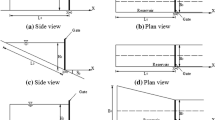Abstract
This paper presents a simple and fast method to calculate flow through a dike breach. The approach was based on two-dimensional numerical simulations of idealized dike breakages at straight river-sections. As a result, computation of discharge through a breach can be achieved by use of the new developed formula (denoted as dike break formula). Furthermore, a methodology that combines one-dimensional hydrodynamic modelling, the dike break formula and a simple GIS-based method to estimate inundation areas is described. This fast and easy-to-handle tool can be utilized for near real-time forecasting or evacuation decisions. Detailed predictions were made for a number of flood and dike break scenarios at the River Rhine to prove the accuracy of the new method compared with two-dimensional numerical models.
Similar content being viewed by others
References
T. I. Aksyonovaa V. V. Volkovich I. V. Tetko (2003) ArticleTitleRobust polynomial neural networks in quantitative-structure activity relationship studies Syst. Anal. Model. Simul. 43 IssueID10 1331–1339
P. D. Bates A. P. J. Roo ParticleDe (2000) ArticleTitleA simple raster based model for flood inundation simulation J. Hydrol. 236 54–77 Occurrence Handle10.1016/S0022-1694(00)00278-X
P. D. Bates K. J. Marks M. S. Horrit (2003) ArticleTitleOptimal use of high resolution topographic datain flood inundation models Hydrol. Process. 17 537–557 Occurrence Handle10.1002/hyp.1113
T. Baur J. Lukowicz Particlevon J. Köngeter (1997) Numerical optimization of a Riverbed-geometry with special regard to erosion J. Watts (Eds) Proc. 3rd Int. Conf. on River Flood Hydraulics Stellenbosch South Africa
W. Bechteler S. Hartman A. J. Otto (1994) Coupling of 2D and 1D models and integration into Geographic Information Systems (GIS) W. R. White J. Watts (Eds) Proc. 2nd Int. Conf. on River Flood Hydraulics John Wiley and Sons Chicester, UK 155–165
Broich, K.: 1997, Computergestützte Analyse des Dammerosionsbruchs, Institut für Wasserwesen, UniBw München, Dissertation am Lehrstuhl Hydromechanik und Hydrologie, Mitteilungen 61, München.
G. Bollrich (1996) Technische Hydromechanik I, Grundlagen EditionNumber4 Verlag für Bauwesen Berlin, Germany
W. D. Curtis J. D. Logan W. A. Parker (1982) ArticleTitleDimensional analysis and the π theorem Lin. Alg. Appl. 47 117–126 Occurrence Handle10.1016/0024-3795(82)90229-4
Dhondia, J. F. and Stelling, G. S.: 2002, Application of one-dimensional two-dimensional integrated hydraulic model for flood simulation and damage assessment. In: R. A. Falconer, B. Lin, E. L. Harris and C. A. M. E. Wilson (eds.), Proc. 5th International Conference in Hydroinformatics, Vol. 1, Cardiff, UK, pp. 265–276.
T. Estrela L. Quintas (1994) Use of GIS in the modelling of flows on floodplains W. R. White J. Watts (Eds) Proc. 2nd Int. Conf. on River Flood Hydraulics John Wiley and Sons UK 177–189
P. Di. Gianmarco E. Todini P. Lamberti (1996) ArticleTitleA conservative finite elements approach to overland flow: the control volume finite element formulation J. Hydrol. 175 267–291
Köngeter, J., Briechle, S., and Liem, R.: 2001, Bestimmung der Überflutungsflächen zur Festlegung der Verbands- und Poldergrenzen der Deichverbände Friemersheim, Orsoy und Poll – Hydrodynamische Simulation ausgewählter Deichbruchszenarien entlang des Rheins, Technical Report, Institute of Hydraulic Engineering and Water Resources Management Aachen, Germany.
Kuipers, J. and Vreugdenhil, C. B.: 1973, Calculations of two-dimensional horizontal flow, Delft Hydraulics Laboratories, Report No. S163–1.
Y. Muslu (2002) ArticleTitleLateral weir flow model using a curve fitting analysis J. Hydraulic Eng 128 IssueID7 712–715
G. Priestnall J. Jaafar A. Duncan (2000) ArticleTitleExtracting urban features from LiDAR-derived digital surface models Comput. Environ. Urban Syst. 24 65–78
Rouvé, G. and Schröder, M.: 1993, One-dimensional vs. two-dimensional prediction of compound open channel flow. In: Advances in Hydro-Science and Engineering. Proc. of the ICHE-’93, Vol. 1, June 7–11, Washington DC, USA.
Verheij, H. J.: 2002, Breaching in Cohesive Soils. WL|Delft Hydraulics, Research Report Q2959, Delft, The Netherlands.
Visser, P. J.: 1998, Breach growth in sand-dikes, Doctoral dissertation (also published in the series “Comm. Hydraulic Geotechn. Eng.”, Fac. Civil Eng. Geosci.), Delft Univ. Techn., Rep. 98–1.
Visser, P. J.: 1999, Breach erosion in sand-dikes. In: Proc. 26th Int. Conference Coastal Eng., Copenhagen, 1998, pp. 3516–3528.
Author information
Authors and Affiliations
Corresponding author
Rights and permissions
About this article
Cite this article
Kamrath, P., Disse, M., Hammer, M. et al. Assessment of Discharge through a Dike Breach and Simulation of Flood Wave Propagation. Nat Hazards 38, 63–78 (2006). https://doi.org/10.1007/s11069-005-8600-x
Received:
Accepted:
Issue Date:
DOI: https://doi.org/10.1007/s11069-005-8600-x




